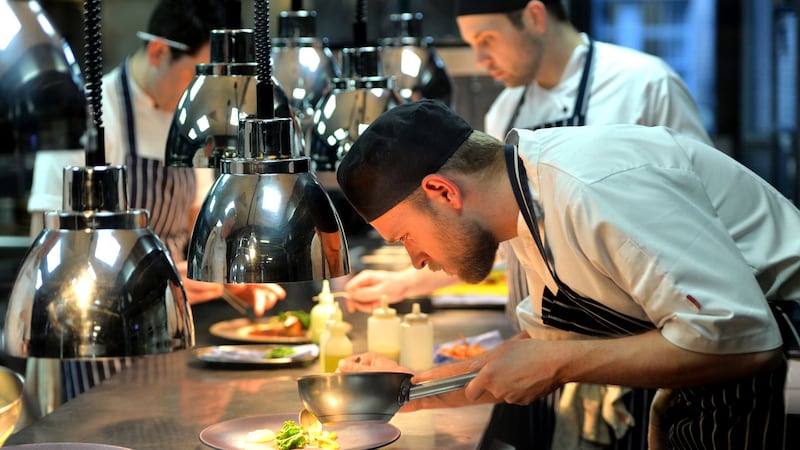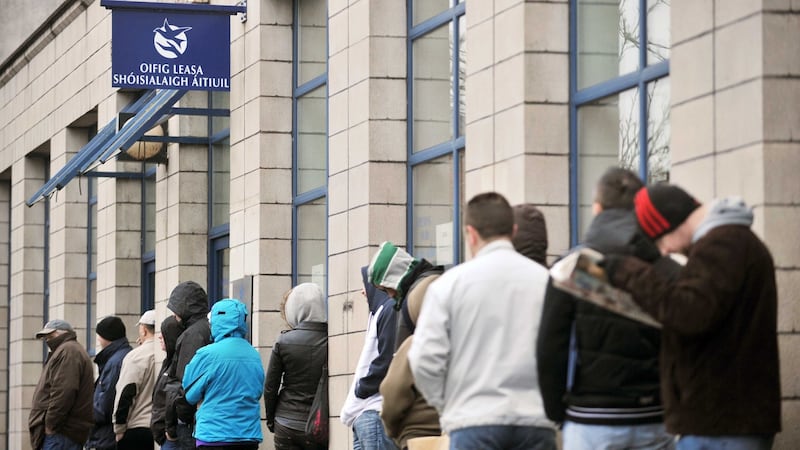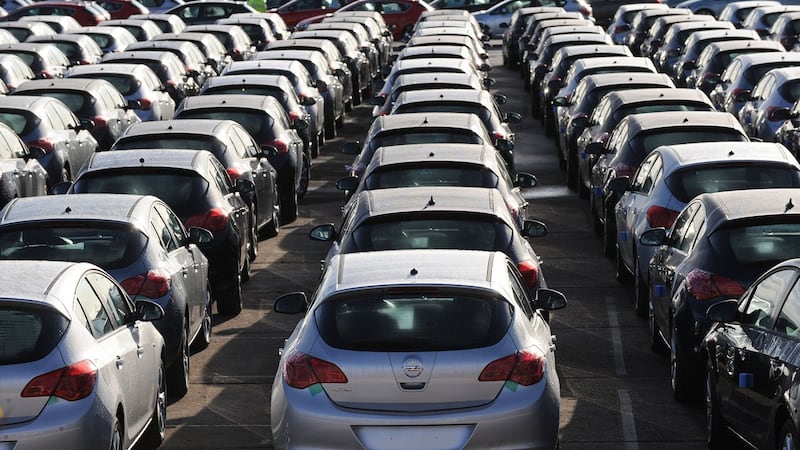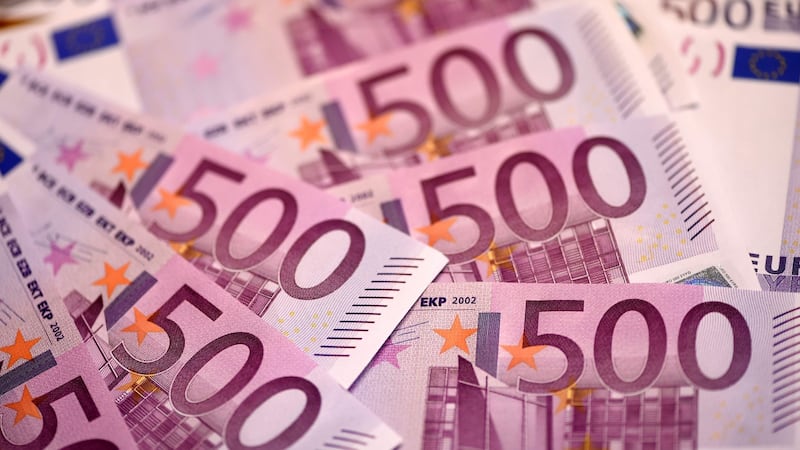Talk of the economic recovery being a "Phoenix miracle" has made it to Dundrum Town Centre, but even in the country's biggest shopping centre the view among shoppers is that the term is not a proper fit.
"I heard that the other day," says a surprised Anna Howard, outside the House of Fraser department store, referring to the phrase used last week by Central Bank chief economist Gabriel Fagan. "Maybe people who have money feel like they can spend it again and people who don't are still being cautious."
“A miracle it definitely isn’t,” adds Anna’s mother Jacqueline. “There’s a lot more confidence in people that have money or didn’t lose their fortune. They have confidence in moving forward again, but there’s a lot of people left behind. People at the lower income levels don’t feel the recovery.”
Emma (26) from Rathfarnham is carrying shopping bags on her way out of the south Dublin shopping centre and checking her phone. "I wouldn't call it miraculous," she says of the bounce-back in the economy. "There is definitely a bit of confidence back but I wouldn't say that it is thriving."
Still, she is experiencing a recovery first-hand in her work in banking and finance. She has just been contacted again by a headhunter trying to recruit her to a new role. “I feel like if I lost my job tomorrow I would definitely be able to go out and get an interview in the next couple of days.”
So things are looking up but no economic apparitions have been spotted in public.
The term "Phoenix miracle" is not Fagan's; it was coined by Guillermo Calvo, the Argentine-American economics professor at Columbia University in New York, to describe an economy that rises rapidly from the ashes of recession, creating new jobs and attracting new investment but without any rise in debt.
Calvo conceived the model after analysing the Asian economic crises of the 1990s, and spotted that the US experienced a similar recovery after the Great Depression with plenty of growth but no new credit.
We may not be back in a credit bubble but the economy seems – to borrow a phrase from Bertie Ahern (although he used the word "boomer") – to be getting boomier.
Sitting in a boardroom of the Central Bank's swanky new offices on the north quays in Dublin, Fagan says that his intention was not to create a new term to rival the overused "Celtic Tiger" or even the more recent "Celtic Phoenix" of fictional Irish Times columnist Ross O'Carroll-Kelly. "It was just simply to say, when we look at the economy, this is a phenomenon that has been observed elsewhere."
We may not be back in a credit bubble but the economy seems – to borrow a phrase from Bertie Ahern (although he used the word "boomer") – to be getting boomier.
Crane-counting on the Dublin skyline is back, house prices are rising by up to 9 per cent nationally and 10.2 per cent in Dublin (says Irish Times-owned property website MyHome.ie and stockbrokers Davy) and couples are camping overnight in cars to be first in line to buy new houses.
Fagan points to inward investment and employment growth as examples of the miraculous recovery. More than 200,000 jobs have been created since 2012, making Ireland "the envy of Europe". Unemployment has fallen from a high of 15.1 per cent in 2012 to 6.4 per cent in March. He sees 90,000 more jobs being created this year and next. Exclude the construction sector, which is still recovering after its collapse, and employment is back roughly where it was at its peak in the mid-2000s.

Calamitous place
This hardly amounts to a boom given that it is just about repairing the damage done since the crash and returning from a calamitous place. While foreign direct investment and US multinationals drove much of the employment growth early in the recovery, the wave of new jobs has spread to different parts of the economy, with the latest Central Statistics Office figures showing employment increasing across all sectors. The rising tide has led the Central Bank to raise both its forecast for wage increases and economic growth this year and next.
From the Central Bank’s new front door at Spencer Dock, you can see 14 building cranes around you. Fagan says the activity in the commercial property sector should not be taken as a warning sign of a potential return to the unsustainable property-driven credit-fuelled splurge that sank the economy almost a decade ago.
"It is unlikely that we will repeat the mistakes of the past, but it cannot be guaranteed," says Fagan from a boardroom that overlooks a hulking frame of new building under construction next door.
Commercial property development is being largely funded by investors from abroad, he says; banks are behaving themselves having got burned, learned their lessons and tightened their lending standards. Financial supervision has improved and banks are “being kept on a tight leash” by the Central Bank. Loan-to-value and loan-to-income ratio restrictions on mortgage lending is keeping a lid on excessive lending.
“It is unlikely that we will repeat the mistakes of the past, but it cannot be guaranteed,” says Fagan from a boardroom that overlooks a hulking frame of new building under construction next door. “If there are changes that are made in response to some of the pressures to policy,” he adds, alluding to the government policies that helped inflate the Celtic Tiger bubble, “it poses risks so we should not become complacent.”
A Central Bank economist's use of the phrase "Phoenix miracle" has raised eyebrows, not least among other economists. Some worry that, notwithstanding the accuracy of the term, it may create some complacency that Fagan is warning against, particularly given the risks facing the economy: from the UK exiting the European Union and the potential impact of US corporate tax reform on Ireland's multinational employers to the housing crisis, the high level of debt and the concentrated nature of the tax base.
“If you use a strict definition, yes, we have seen the stock in credit fall, and yet the economy is growing,” says Dermot O’Leary, chief economist at Goodbody Stockbrokers.
“But it is a little bit dangerous because it may bring about an attitude that everything is very rosy whereas if you look at where the risks are at the moment there are still significant ones. It is somewhat dangerous as to what it does to the psychology of thinking around how sustainable the recovery is.”
The shortage of new housing units after years of inactivity in the construction sector lays bare one of the biggest problems facing the economy. The Housing Agency has said that 81,000 new homes are needed by 2020 to meet projected demand. Just under 15,000 new homes were completed last year, and work began on another 13,234 homes, so the country is falling well short.
This explains why house prices are increasing so quickly in an illiquid market and why average rents rose 13.5 per cent in 2016 – their highest level on record – and are climbing faster since property website Daft.ie first began tracking rental prices in 2002.There is still also a heavy debt hangover in Irish households from the boom and bust as they continue to try to solve past mistakes.
Debt as a proportion of income was reduced by the highest amount of any country in the European Union last year, but Irish households were still the fourth most indebted in the EU. Likewise, small businesses are still paying off legacy debt and are not confident enough to borrow.

"Whilst we are certainly not in bubble territory, the fact that credit is contracting is not something we should be patting ourselves on the back about," said Davy economist Conall Mac Coille.
The mortgage market is not yet back to what is considered normal levels as more debt is being paid off than being drawn down. Residential mortgages totalled €5.6 billion last year, according to Bank and Payments Federation Ireland, still below a level that economists consider a normal market. Increases in approvals suggest this could reach €10 billion by 2020, according to a conservative Davy estimate.
Increasing house prices driven by the shortage of properties on the market and easing borrowing rules will also help to drive up debt levels. Fagan expects the overall stock of loans to start growing again within the next year or two. “We are close enough now if you look at growth rates,” he says.
Outstanding debts are, for many, still a big part of the problem, however, and the recovery in this area has been far from miraculous. Some 77,493 home mortgages (out of a total 738,506 in the country) had fallen behind on repayments at the end of last year, Central Bank data shows.
A rising market is curing some bad mortgages but there are still many hopeless cases where people will inevitably have to leave homes, including some of the worst cases: there are 33,447 mortgages in arrears for two years or more.
While the recovery is broadly based in that jobs are being created in sectors across the economy, it has not been evenly spread.
“There is a big difference between now and 2014, so cases that we saw as being pretty hopeless in 2014 are now solvable because there is more activity, more people working, more people better off,” said Ross Maguire, chief executive of New Beginnings, which helps people struggling with their mortgages.
“That doesn’t apply across the board. I think there is a rump of 5,000 to 10,000 cases that can never be solved because of non-economic factors such as age – people are too old to repay large mortgages – marital break-up and people whose income is never going to go back to where it was.”
While the recovery is broadly based in that jobs are being created in sectors across the economy, it has not been evenly spread. The majority of the new jobs created over the last four years are higher-skilled positions, being filled by candidates with third-level qualification.
Homelessness campaigner Fr Peter McVerry gets annoyed with terms like “Phoenix miracle” when homelessness is at record levels and 7,100 people are seeking emergency accommodation, including working people who simply cannot afford their mortgages or skyrocketing rents.

“The recovery has left a lot of people behind and they are not just poor people. These are people who have worked hard, done all they were told that would make them successful. Those who are being left behind who read that will just feel more and more that they don’t count and their perspective is irrelevant to government and policies being pursued in this recovery.”
Dr Seán Healy, director of think tank and advocacy group Social Justice Ireland, takes issue with economic analysis skewed by foreign investment at a time when a major programme of investment in social housing and rural broadband is required and there are 91,000 people on housing waiting lists.

“We have serious questions about the measurement of growth, GDP and so on, and the idea that we have delivered this miracle rings very hollow to a very high percentage of people in Ireland.” Fagan acknowledges the main beneficiaries of the economic recovery are people finding jobs again. “It doesn’t mean when we say a broadly-based recovery that everyone is benefiting from the recovery – it just means that it is spread across different sectors.”
Pursestrings loosening
Even those who have gained from the "Phoenix miracle" are watching their money and being more circumspect about their spending, unwilling to get stung like others did in the past. Businesses that rely on consumer confidence and higher disposable income spending told The Irish Times that people have started spending again but not like before. They are instead more discerning and careful with their money.
New car sales last year reached 142,988, their highest level since 2008, but purchases of “171-reg” cars are down this year, though still healthy at levels recorded in 2015.

Gavin Hydes, chief executive of Joe Duffy Motors, which operates 12 car dealers in Dublin, Meath and Limerick, believes car sales have been affected by uncertainty about the future and concerns about Brexit. Restaurants appear to be enjoying greater confidence in short-term consumer spending, he says. "Cars are a bigger purchase. Anything that affects the medium term affects car sales because it is a medium-term acquisition."
At Chapter One on Parnell Square in Dublin, one of 12 Michelin-starred restaurants in the country, chef Ross Lewis says he has seen "a little bit of extra volume" in business, including returning customers whom he has not seen for a while.
“I can see people getting a little bit more confident and slightly spending up a bit,” he says, “but I wouldn’t see them going crazy. People are going €5 or €10 up on a bottle of wine.”
Wild sums
Peter Dunne, director of Mitchell & Son Wine Merchants in the IFSC in Dublin, says people are shelling out more on whiskey and gin but not the wild sums they spent on wine during the boom years.
“It was out of control almost what people were prepared to spend on wine for a special dinner. Those days are not completely gone but it is not noticeable that they are on the way back.”
In no way is it back to where it was in 2005 or 2007, but every year it is increasing. There is certainly a lot of positively out there.
In the art world, Mandy Williams, director of the Oriel Gallery in Dublin, says that sales are up and there are lots of new clients, but there are fewer impulse purchases like during the Celtic Tiger years; customers won’t spend vast sums on paintings they are unlikely to make money back on at a later date.
“They want to know the history of the picture. They just want to be comfortable,” she says. “There is no problem spending money, but they just want to be more cautious.”
On the art auction side, James O’Halloran, managing director of Adam’s Auctioneers, has noticed more optimism among buyers and more traffic, particularly from new customers such as young doctors and lawyers. However, he has not seen a huge increase in prices being paid.
“There is less risk-taking. People are looking at works by artists within what they would see as safe parameters. They want to know if things went south in the next little while again they wouldn’t be left standing with something that nobody wants.”
Tailor Louis Copeland reports that sales are up 7-10 per cent on last year across his six shops, and that he has even seen property developers who were "out there years ago" starting "to trickle back a little bit".
“In no way is it back to where it was in 2005 or 2007, but every year it is increasing. There is certainly a lot of positively out there. You get a few good weeks and then you get a kick in the balls and it dies. It is up and down.”
Christopher Andrews, operations director of Weir and Sons jewellers on Grafton Street and in Dundrum, says that sales volumes have fallen slightly but people are still spending and sales values are up. "People have more money than they had a year ago, but they are not necessarily spending it with us. Last year they were spending more on cars. This year they might be spending it on something else, maybe property."

Andrews says “Phoenix miracle” is a “nice soundbite” but he feels it will take the retail sector longer to feel it than other parts of the economy. “There is a good story there in Ireland compared with back in 2012 and 2013. The country does seem to be sorting itself out and coming back strongly.”
Fagan says the Celtic Tiger “mutated” into a credit-fuelled property bubble but the country’s underlying economic model that emerged in the 1990s based on inward investment, integration in the global economy and exports has remained sound and helped the Irish economy recover.
"We are extremely lucky – we got away with it," he says. "If you look at other countries – don't forget Phoenix comes from Greek mythology – there is no Phoenix miracle in Greece, and some of the other crisis countries are not experiencing strong growth."












